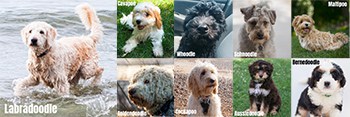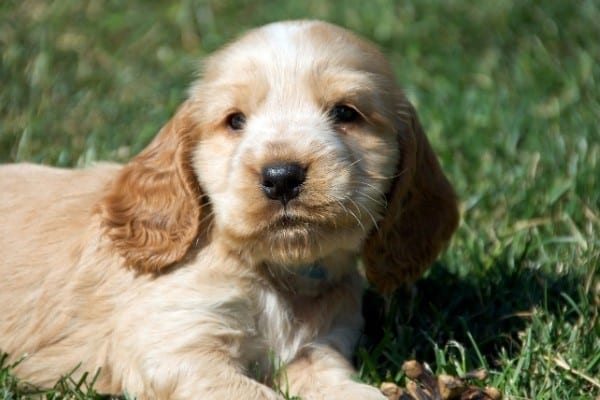
Who isn’t instantly smitten by the large, soulful eyes and the sweet disposition of the Cocker Spaniel?
I had a childhood friend who had a black Cocker Spaniel named Winston. What an incredibly gentle, smart, and all-around great dog he was.
When it was discovered that my friend’s little brother had developed severe asthma and allergies, I remember how she begged and pleaded with her parents to get rid of her brother rather than the dog.
Well, it all worked out in the end.
They kept the baby brother of course, and her grandfather who lived a mile and a half away wound up taking in Winston, so we all got to visit him on a regular basis.
I often think of that dog and would love a Cocker Spaniel of my own one day, but I have a special place in my heart for mixed breeds, thanks to my Chachi.
A Cocker Spaniel mix just might be the perfect solution, and there are lots to choose from.
Join me as we explore some of the more popular Cocker Spaniel mixes and take a look at the Cocker Spaniel breed itself, as evidence of its contribution to the mix will be prominent in the pups.
Table of Contents
Cocker Spaniel Facts
History
Did you know that one of the two dogs brought along on the Mayflower was a Spaniel?
The dog was likely quite different in terms of type compared to the modern Cocker Spaniel, but he was a Spaniel nonetheless, and it was this “type” from which all of today’s various Spaniels descend.
Though written records are nonexistent, these early Spaniels are thought to have originated in Spain before becoming favored by the English for their superb hunting abilities.
Breed Development
Prior to the 1800s, a Spaniel was classified as either a land Spaniel or a water Spaniel as these highly prized bird dogs had yet to be divided into separate breeds.
It wasn’t until the mid to late 1800s that breeders began to focus on specific Spaniel types and separate Spaniel breeds began to emerge from the large and varied group.
At first, Spaniels weighing more than 28 pounds were deemed to be Field or Springer Spaniels, and the smaller Spaniels were termed Cockers because they excelled in hunting woodcock (long-billed, stout game bird similar to a snipe).
Over time and thanks to the start of structured dog conformation shows and trials, distinct Spaniel breeds were standardized.
The Cocker Spaniel, Field Spaniel, English Springer Spaniel, and the Sussex Spaniel, to name a few, can all trace their beginnings to the original Spaniel type, though today they differ significantly in appearance, size, form, and function.
A Breed Divided
This however, was not quite the end of breed divisions as Cocker Spaniels were being bred in America for different qualities than their English counterparts.
American Cocker Spaniels were bred to be smaller and showier with pronounced domed heads while the English Cocker Spaniels were taller, rangier, and had longer heads.
Though the Cocker Spaniel was originally recognized in 1884 by the American Kennel Club, it wasn’t until 1946 that a distinction between the Cocker Spaniel (American version) and the English Cocker Spaniel was recognized.
Fame Achieved
The Cocker Spaniels’ fame skyrocketed after winning Best in Show titles at the Westminster Kennel Club Dog Show in 1921, 1940, and again in 1941.
They became so popular that they held the number one position for AKC registrations for 16 straight years (1936 – 1952).
Fame Lost
Alas, soaring popularity often comes with a cost.
Unscrupulous breeders and puppy mills with no regard for breed standard or health started mass producing Cocker Spaniel puppies.
Numerous health conditions and temperament problems started appearing in these ill-bred pups, and breed popularity declined sharply in a classic case of profit over passion.
Hope for the Future
Thanks to the work of dedicated breeders, today many of the health issues and negative disposition traits that once plagued the breed have been resolved and the Cocker Spaniel now ranks #30 on the AKC popularity chart.
The future of the breed is truly in the hands of passionate breeders wishing to restore this gentle beauty to the glory he once so richly enjoyed.
Size
Cocker Spaniels have a compact build and are relatively small for a sporting breed.
Male Cocker Spaniels should be 14 ½ to 15 ½ inches tall at the withers and weigh between 25 and 30 pounds.
Females should stand 13 ½ to 14 ½ inches tall and weigh just 20 to 25 pounds.
Colors

The Cocker Spaniel breed standard allows for a great variety of coat color.
There are three basic color groupings in the breed: black (includes black with tan points), any solid color other than black (ASCOB), and parti.
Solid black and solid buff are by far the most common, but other possible solid colors include:
- Brown (chocolate) or brown roan.
- Red or red roan.
- Silver.
- Cream.
- Gold.
- Sable.
- Blue roan.
These colors may be paired with white in parti-colored dogs, and in several colors, tan points are acceptable too.
Even parti-colored dogs can show the tan points, making them tricolored Cockers.
Allowable markings include merle, roan, and ticking, and the standard allows for a small amount of white to be present on the chest and throat of solid-colored dogs.
The wide variety of color possibilities means there’s something for everyone and breeders can focus on breeding health, vigor, and excellent temperament into their lines rather than concentrate primarily on coat color.
Temperament
Cocker Spaniels are one of the few breeds commonly described as “merry.”
They typically are perpetually cheerful and optimistic with what can only be described as a joyful outlook on life.
Cockers are incredibly devoted to their owners and love human companionship. Thus, they do best in homes where someone is usually home with them throughout the day.
This is a playful breed that is always up for fun, but Cockers are also quite willing to work hard to please, which translates to mean that they train easily when properly motivated.
Cocker Spaniels are usually gentle and patient with children and will happily engage in all sorts of play with younger family members.
They’ll also get along quite well with other household pets, the exception being pet birds, to which they may very well develop an obsession, as they were bred to do just that.
While temperament may be, to a certain extent, shaped through raising techniques, training, and socialization (see our checklist here), much of the Cocker’s temperament is the result of breeding.
Negative traits, such as aggression or neurotic behavior, are often seen in poorly bred dogs from puppy mills and careless breeders who have no real interest in the breed or improving upon it.
On the other hand, dedicated breeders who breed specifically for temperament and to improve the breed as a whole consistently produce Cockers with stable, even temperaments.
These breeders are the ones you should seek out, especially if you have children in the home or if you want a Cocker Spaniel that exhibits the disposition that once made the breed so incredibly popular.
Exercise Requirements
Most Cocker Spaniels will need about one hour of exercise daily. This should be broken up into several sessions throughout the day and need not be limited to just walks.
Active playtime outside, such as a rousing game of fetch or running around with a canine companion counts as exercise time too.
Note that Cocker Spaniels from working lines may require more daily activity than those from show lines, as they were bred specifically to hunt alongside their master for hours at a time.
Grooming
Cocker Spaniels’ fur grows quickly, and without routine maintenance, the coat will develop tangles that will then develop into painful mats that tug on the skin.
Thoroughly brushing the coat is of utmost importance, especially if it is not kept short.
- A stainless steel comb will easily work through the thick coat, reaching all the way down to the skin to help remove tangles and break up mats.
- A dual-sided brush with soft bristles on one side and metal pins with rounded tips on the other is perfect for smoothing the coat, removing loose hairs, and adding sheen as it will evenly distribute naturally occurring oils.
- A slicker brush can be used on the longer portions of the coat, but extra care must be taken around the sensitive ears.
- An undercoat rake can be a huge help during seasonal shedding to remove shed fur before it turns into a matted mess or is left behind all over your home.
- Sharp trimming scissors are useful for cleaning up the fur around the ears, muzzle, feet, and genitals.
Most Cocker Spaniels visit a professional groomer once every four to six weeks, but some owners prefer to tackle the job themselves, and it’s really not that difficult to do.
In the following video, you’ll learn the basics of an at-home DIY Cocker Spaniel haircut.
Like any other dog, a Cocker Spaniel will also need to have the nails trimmed once per month and the teeth brushed several times each week with a dog-safe toothpaste.
However, this breed is prone to ear infections, so keeping a close eye out for trouble is critical.
Every couple of weeks, carefully examine each ear for redness, odor, and buildup.
Using an ear cleanser made for pets (this one is ideal and priced reasonably), add a few drops of solution in each ear, massage the base of the ear to allow the product to penetrate deeply, wipe out excess solution with a damp cloth, and allow the dog to shake his head to fling out excess.
Health
The Cocker Spaniel does have a few health issues that are relatively common and a few that occur less frequently within the breed but still are something of which to be aware.
Eye conditions, such as cherry eye, progressive retinal atrophy, cataracts, glaucoma, ectropion, distichiasis, and dry eye may be problematic in some Cockers.
Joint and skeletal conditions, such as hip or elbow dysplasia, patellar luxation, and intervertebral disc disease have been seen in the breed as well as several blood disorders, like Von Willebrand’s disease and thrombocytopenia.
Cocker Spaniels are at a somewhat elevated risk for hypothyroidism, epilepsy, heart disease, dental disease, cancer, and several skin conditions as well as liver issues, such as portosystemic shunt and hepatitis.
It’s important to keep in mind that these conditions are merely possible and many other breeds also have a predisposition to these common canine conditions, so don’t be intimidated by what may go wrong healthwise with a Cocker Spaniel.
Rather, focus on providing a healthy lifestyle complete with excellent nutrition and plenty of physical activity, and be diligent with quality, routine veterinary care.
Breed Highlights
| Origin | Spain, refined in England and again in America |
| Height | 13 ½ – 15 ½ inches tall |
| Weight | 20 – 30 pounds |
| Colors | Black, many solid colors, parti colors |
| Temperament | Cheerful, gentle, easy going, eager to please |
| Good family dog? | Excellent |
| Exercise needs | Average |
| Excessive barking? | No |
| Trainability | Easy |
| Intelligent? | Yes |
| Grooming requirements | Fairly high |
| Shedding | Average |
| Health issues | Eye conditions are the biggest concern |
| Life expectancy | 10 – 14 years |
Mixed Breed Dogs

A purebred Cocker Spaniel is a superb dog both in the field and as a family pet, but when combined with another breed, the few negative aspects often disappear entirely and the result is a totally unique combination with traits from both parents and an appearance all their own.
What to Expect
Learning to expect and appreciate the unexpected goes hand in hand with owning a mixed breed.
With a Cocker Spaniel mix, the dog may be practically indistinguishable from a purebred Cocker, he may strongly resemble the other parent breed, or more likely, he’ll be a delightful combination of both parents.
Of course, much will depend on the other breed used to produce the Cocker Spaniel mix, but you can generally expect a friendly, cheery, agreeable, and affectionate dog who needs about 45 minutes of exercise daily, routine grooming, and plenty of attention and unconditional love.
Be aware that mixes from a first generation pairing, i.e., a Cocker Spaniel to another purebred dog, will be the most variable in terms of appearance, size, coat, color, shedding, temperament, etc.
Cocker mixes who are the product of generational breeding (e.g., Cockapoo to Cockapoo or Cockapoo to a Poodle) tend to be more predictable for certain traits, especially when obtained from a breeder who has been developing a line for many years.
Why Are Some Mixed Breeds So Expensive?
Mixed breed dogs, on the whole, are quite common. Just take a stroll through your local animal shelter, and you’ll see what I mean.
However, mixed breed dogs who were intentionally created to fulfill a certain role or purpose, are known as designer dogs, and they can cost quite a bit, in some cases even more than a purebred dog.
The reason for the high price tag is actually threefold.
First of all, many of the designer breeds are currently in high demand.
Take for instance the Goldendoodle (learn all about them here). Fans are simply enamored with their soft coat, teddy bear appearance, and amazing personality.
Other popular designer breeds, such as the Cockapoo, possess highly regarded traits, such as low to nonshedding tendencies and impressive intelligence.
Secondly, to produce designer breeds, breeders must maintain not one breed but two, often several of each breed.
That means an increase in feeding and veterinary costs, more screenings for genetic conditions, more room for housing, more of everything.
These additional costs are naturally reflected in the price of the puppies.
Factor in the fact that some breeders practice generational breeding, which means even more dogs and their associated upkeep, and you can see why prices are often exorbitant.
Lastly, designer breeds are not your run-of-the-mill mutts.
Many dogs used in breeding programs are pedigreed and some may come from championship bloodlines or have claimed a few winnings themselves.
This status often boosts the price considerably.
Their offspring may be registered with groups like the Designer Breed Registry and even with the AKC Canine Partners Program where they can compete in various sporting events.
Are Mixed Breed Dogs Healthier?
A phenomenon known as hybrid vigor, or heterosis, is often noted in mixed-breed dogs.
Simply explained, it is the above-average health seen in many mixes that is typically attributed to the larger gene pool when combining separate breeds.
While some dispute the validity of this notion, there is no denying that many of the conditions commonly seen in the parent breeds are practically nonexistent in their mixed-breed puppies.
Pros
For reasons that are still not entirely clear, mixed dogs seem to inherit the best qualities from each parent breed.
This is likely largely due to careful breeding designed to strengthen desirable traits, such as low shedding or calm temperament.
Many of the more common Cocker Spaniel mixes are bred to have incredible personalities, minimal shedding, soft and manageable coats, and above-average health.
Cons
Unpredictable
Aside from mixes who have been generationally bred for years and have fairly predictable traits, there can be quite the element of surprise in mixed dogs.
Even within one litter of mixed breed puppies, there will be quite a lot of variability in terms of physical appearance and even temperament.
Some puppies will favor one parent, some the other, and some will resemble both equally, but they will each be unique in their own way and will change quite a bit as they grow.
Coat color may darken or lighten with age, and certain physical traits may become more pronounced as they mature.
Remember the famous line from Forrest Gump about life being like a box of chocolates?
“You never know what you’re gonna get,” is certainly applicable to a mixed breed.
Expensive
While many mixed breeds are no more than the cost of adoption fees at the animal shelter, designer mixes often come with a high price.
Some of the more popular designer breeds typically sell for well into the thousands.
Generally, the more popular the mix, the higher the price will be, often more than what you would expect to pay for a purebred dog.
6 Most Popular Cocker Spaniel Mixes
Cocker Spaniels are often mixed with similarly sized breeds to produce a wide variety of adorable mixes.
While the possibilities are many, here we’ll focus on only those that have quickly gained traction and are enjoying a rapid rise in popularity.
Cocker Spaniel and Poodle = Cockapoo

Also known as: Cockapoodle, Cockerpoo, Cocker Spaniel Poodle Mix
Cockapoo Temperament
Most Cockapoos are extremely affectionate, gentle, smart, and playful. They do very well with children of all ages and are usually eager to make new friends.
They typically are friendly toward other dogs and even get along well with cats, especially if they have been raised together.
Cockapoo Average Size
A Cockapoo’s size is dependent on the size of Poodle used in breeding.
First generation pups with a Toy Poodle parent will be roughly 9 – 10 inches tall and weigh about 12 pounds.
Those with a Miniature Poodle parent will be approximately 11 – 14 inches tall and between 12 and 18 pounds.
Standard Poodle’s will produce Cockapoos who are up to 18 inches tall and about 20 pounds.
Multigenerational Cockapoos, that is those with two Cockapoo parents, will be on average 1 foot tall and weigh about 15 pounds.
Cockapoo Colors
Cockapoos are available in many colors, thanks to the variety found in both parent breeds.
Possible solid colors include black, cream, apricot, chocolate, and red.
Parti-colored Cockapoos are common as well, typically with a base coat of white and one or more colors occurring in large patches over the body.
Cockapoo Exercise Needs
Cockapoos are fairly active and energetic. At least an hour per day of physical activity will be needed, though some Cockapoos may require even more.
Exercise time should be broken into several periods spaced throughout the day and may consist of walks, jogs, outdoor playtime, off-leash runs in an enclosed area like a dog park, or various dog sports, such as agility training.
Cockapoo Trainability
Both the Cocker Spaniel and Poodle are intelligent and eager to please their owners, so it’s no surprise that Cockapoos are the same.
With consistent commands, frequent practice, and plenty of positive reinforcements, Cockapoos can be trained quickly and easily for basic obedience as well as for more advanced commands and tricks.
Cockapoo Grooming Requirements
A thorough brushing all the way down to the skin every few days is necessary to prevent mats and keep the coat in top shape.
A bath and trim every six to eight weeks will keep the coat healthy and at a manageable length. Nail should be neatly clipped at each trip to the groomer.
Cockapoos’ ears are prone to infection and should be inspected and cleaned at least every other week.
Also, any hair growing within the ear should be plucked to improve air circulation, and the teeth should be brushed three or four times per week.
Cockapoo Average Price
Well-bred Cockapoos are typically priced between $1,000 and $2,500.
Inexperienced breeders and those only in it for the money may have bargain prices, but buyer beware – cheaper Cockapoos may come with a range of health and/or temperament issues due to poor breeding standards and practices.
If you’d like more information on these sweet, friendly dogs, we cover the adorable Cockapoo extensively here.
Table of Contents
Cocker Spaniel and Bichon Frise = Cock-a-Chon
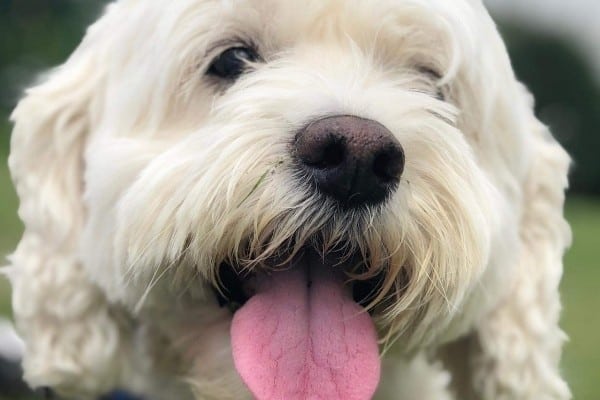
Also known as: Cockerchon, Cocker Frise, Bichon Cocker, Bichon Spaniel, Cocker Bichon, Cocker Spaniel Bichon Mix
Cock-a-Chon Temperament
Thanks to the Bichon Frise contribution to this mix, most Cock-a-Chons are very playful and delight in entertaining those around them with cute antics and trained or self-taught tricks.
Some may be easily excited while others will be more laid back.
They are affectionate and gentle, do well with children, are smart and easily trained, and are usually not big barkers.
Cock-a-Chon Average Size
The average Cock-a-Chon will be roughly 12 – 14 inches tall at the withers and weigh between 15 – 20 pounds.
Some may fall outside of these estimates due to the size of their parents or obesity issues, but because both parent breeds have had set standards in place for many years, most Cock-a-Chons will be within these ranges.
Cock-a-Chon Colors
Cock-a-Chons are most commonly found in black, brown, tan, cream, white, and various combinations of these colors.
Shades of tan, either in a solid coat or a parti-colored coat, are the most common.
Cock-a-Chon Exercise Needs
Cock-a-Chons are not usually overly active or energetic, but they often exhibit short bursts of high energy that will be quite noticeable as they madly dash around the house or yard at full speed for several minutes and then calm right down again.
Generally, two walks or periods of active play, each about 20 – 25 minutes long, is sufficient for this adorable cross breed.
Cock-a-Chon Trainability
Many Cock-a-Chons are natural performers and will readily learn anything new so they can show off their new tricks.
Both parent breeds have a strong desire to please their owners, so training for obedience, housebreaking, and advanced tricks usually presents very little challenge.
Cock-a-Chon Grooming Requirements
Like all dogs, a Cock-a-Chon will need the teeth brushed several times each week and the nails clipped, the ears cleaned, and a bath every four to six weeks.
The coat will need to be brushed thoroughly a few times each week, and a full-body clip will likely be needed every six weeks or so to keep the coat at an easy-to-manage length.
Cock-a-Chon Average Price
It is fairly common to find a Cock-a-Chon for less than $1,000, though some may be more expensive if they have unusual colors and markings or an impressive pedigree.
In this case, prices may soar to as much as $2,000.
Beware of those priced at just a few hundred dollars as they are likely not the product of quality, recommended breeding practices.
Cocker Spaniel and Maltese = Silky Cocker

Also known as: Cocker Malt, Maltese Cocker, Maltese Cocker Spaniel Mix
Silky Cocker Temperament
With the cheerful, willing Cocker Spaniel personality combined with the charm and boldness of the Maltese, Silky Cockers are truly the best of both worlds.
They are affectionate people pleasers with a confidence and loyalty common to small dogs.
They thrive in a family setting, though supervision is a must if young children are present, and they may become jealous if not given adequate attention.
Silky Cocker Average Size
Although size can vary greatly, most Silky Cockers will be 10 – 12 inches tall at the shoulder and will weigh between 10 and 15 pounds.
Those strongly taking after the Maltese will naturally be smaller, and those who favor the Cocker Spaniel may be quite a bit larger.
Silky Cocker Colors
There is a broad range of color possibilities with these designer dogs and their silky, wavy coats.
White, chocolate, cream, tan, red, and parti-colored patterns are common, though white base coats with various shades of tan accents are most commonly seen.
Silky Cocker Exercise Needs
These little dogs don’t need too much structured exercise time. A daily total of around 45 minutes of physical activity is usually adequate.
This could be in the form of a couple of short walks, a short walk and a vigorous play session, or a couple of active playtimes – whatever works best for the individual Silky Cocker.
Silky Cocker Trainability
While there is no doubt that Silky Cockers are quite intelligent, they may inherit a bent toward stubbornness from the Maltese.
Keeping the training sessions brief and engaging, immediately rewarding desired behavior, and being consistent with commands will produce the best results.
Harsh training and raised voices will not be effective with these sensitive dogs.
Silky Cocker Grooming Requirements
Daily brushing is recommended if the coat is kept long. Shorter coats will need less frequent brushing.
A bath and trim will be needed about every four to six weeks to keep the coat in good condition.
To prevent ear infections, the ears should be cleaned at least once per month. Routine nail and dental care are required, just like with any other breed.
Silky Cocker Average Price
Silky Cockers aren’t very common, and you may have a long wait on a breeder’s waitlist.
Available puppies are usually more than $1,000, and some may be as much as $2,000, depending on current demand and the color and markings on the puppies.
Cocker Spaniel and Cavalier King Charles Spaniel = Cockalier
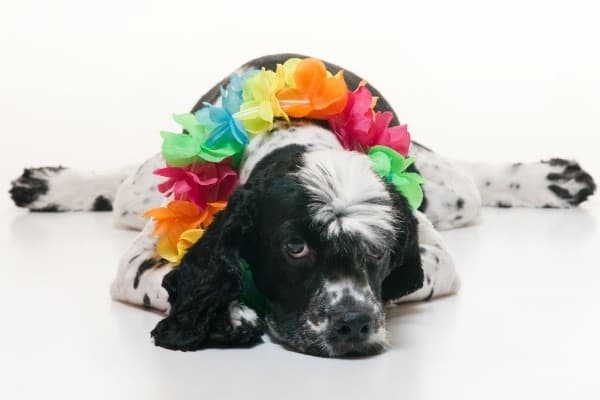
Also known as: Cavalier Spaniel, Cocker Cavalier, Cocker Spaniel Cavalier Mix
Cockalier Temperament
Incredibly sweet, the Cockalier is a fun-loving, affectionate, devoted companion, perfect for individuals and families alike.
These gorgeous crosses are quite people oriented and love to be part of everyday activities, whether it involves romping around the yard or relaxing indoors.
They generally do well with other pets and are playful and patient with children too.
Cockalier Average Size
The majority of Cockaliers will weigh between 15 and 25 pounds and stand around 14 inches tall.
Smaller and larger individuals are possible of course, but because the two parent breeds are similar in size, there will be less variation in size with this Cocker mix than with others.
Cockalier Colors
Since Cavaliers may be white and chestnut, ruby, black and tan, or tricolor, any of these may appear in Cockaliers as well.
Standard Cocker colors and markings are common too, but you’ll find that most Cockaliers are white marked with various shades of brown or are tricolor.
Cockalier Exercise Needs
Neither parent breed is extremely high energy, so it stands to reason that Cockaliers need only moderate daily exercise, and this is indeed the case.
Around 45 minutes to an hour of exertive activity is typically all that’s needed each day, and that may be broken into several short sessions if desired.
Cockalier Trainability
Because both breeds contributing to the Cockalier have a very agreeable and eager-to-please temperament, training is rarely a problem with this crossbreed.
Cockaliers are eager learners, and with lots of positive reinforcements, they can quickly learn a wide variety of commands, hand signals, and tricks.
Cockalier Grooming Requirements
For most Cockaliers a thorough brushing twice per week is usually enough to keep tangles at bay.
Some may have longer coats that will benefit from an occasional trim, while others may only have medium-length coats that can forego clipping entirely.
A monthly bath, including a high-quality conditioner, will be needed as will a monthly nail trimming.
Ear cleaning should take place every few weeks and the teeth should receive a good brushing several times each week.
Cockalier Average Price
Cockalier puppies are typically around $2,000, but those out of excellent bloodlines or with particularly pretty markings may be more than $3,000.
For those with a high price tag, be sure to ask the breeder about the parents’ pedigrees and genetic testing performed to ensure that you are actually getting a well-bred dog.
Cocker Spaniel and Beagle = Bocker
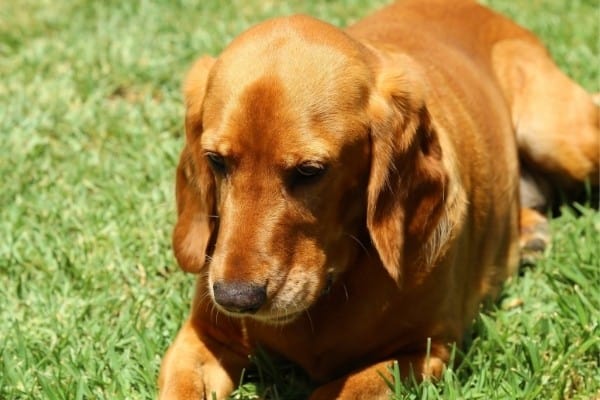
Also known as: Cocker Beagle, Beakers, Beagle Spaniel. Beagle Cocker Spaniel Mix
Bocker Temperament
With not one but two parents described as being “merry” by the AKC, the Bocker has high standards to live up to, but he does not disappoint.
Bockers are cheery, gentle, full of life, and happy-go-lucky.
They can be an ideal addition to active families, as they love to play and are totally devoted to their people.
Note that although these mixes are alert and make good watchdogs, they also may have a high prey drive and take pleasure in chasing smaller critters.
Bocker Average Size
Beagles come in two size varieties: under 13 inches tall or 13 – 15 inches tall.
Depending on which type of Beagle is used in the pairing, a Bocker may be 10 to 13 inches at the withers and weigh less than 20 pounds, or he may be 13 to 15 ½ inches tall and weigh 20 to 30 pounds.
Bocker Colors
Both parent breeds have a long list of color possibilities, so the Bocker does as well. Bockers may be solid in color, but bicolor and tricolor dogs are common too.
They can be black; various shades of brown, including tan, cream, buff, and gold; red; blue; lemon; white; silver; roan; or a pretty combination of two or three colors.
Bocker Exercise Needs
Bockers are likely to be more active than other Cocker Spaniel mixes thanks to the high-energy levels of the Beagle.
Most Bockers will need at minimum an hour of intense exercise daily, though many will require more.
These energetic dogs could turn to destructive behaviors if not given an appropriate outlet regularly for their pent-up energy.
Bocker Trainability
With hunting backgrounds on both sides of the family tree, Bockers can definitely be successfully trained.
However, first-time dog owners may struggle with the stereotypical “Beagle stubbornness” sometimes noted in this cross.
Patience and consistency, along with plenty of praise and rewards when success is achieved, will get the job done, but all bets may be off if a tantalizing scent snags his attention as this cross can be sometimes easily distracted.
Bocker Grooming Requirements
Many Bockers will inherit a coat similar to that of the Beagle – short, course, and sleek.
This type coat will only need brushing about once a week to control shedding and remove dirt and debris.
Bockers inheriting a medium-length coat will need to be brushed several times per week to prevent mats.
A monthly bath should be sufficient, and bath time is an ideal opportunity to tackle two other grooming chores: ear cleaning and nail clipping.
Three or four times each week, the teeth should be brushed to prevent future dental issues.
Bocker Average Price
Bocker prices vary tremendously. Some are listed at just a couple of hundred dollars, while others are priced close to $3,000.
Generally, you should not expect to pay more than $1,000 for a Bocker puppy, but be prepared to travel to the closest breeder as there are not many breeders currently focusing on this Cocker mix, though hopefully that will soon change.
Table of Contents
Cocker Spaniel and Dachshund = Docker

Also known as: Spaniel Doxie, Doxie Cocker, Cocker Spaniel Dachshund Mix
Docker Temperament
Typically sweet, good natured, and playful, the Docker becomes very attached to his family and loves nothing more than being with those he loves.
However, Dockers who inherit a Dachshund temperament may be prone to barking and don’t always do well with young children.
Though generally good with other dogs, prey drive may be an issue whenever small animals are encountered.
Docker Average Size
Although the Dachshund comes in a miniature size, the larger standard-size Dachshund is usually used to create the Docker.
Most Dockers will be 9 – 13 inches tall at the shoulder and weigh between 18 and 25 pounds.
Docker Colors
There is a nearly endless array of color possibilities with Dockers as both parent breeds come in numerous color options.
Black, red, cream, chocolate, fawn, tan, and wheaten may occur in either a solid coat or a combination coat with two or three colors.
Pretty markings, such as sable, brindle, dapple, and piebald, are possible as well.
Docker Exercise Needs
Dockers are fairly energetic and can get into trouble if not given adequate amounts of daily exercise.
This cross will need 45 – 60 minutes of vigorous walking or play each day, though the total amount can be split into several exercise periods spaced evenly throughout the day.
Docker Trainability
Dockers are quite intelligent, but stubbornness can cause challenges at training time.
Those with a Cocker Spaniel temperament will train easily, but those with a more Dachshund-like mindset will need more time and patience to become obedient, and even then, they may develop selective hearing if your commands don’t mesh with their agenda.
Docker Grooming Requirements
While Dachshunds can come with a long coat, short and smooth coat, or a wiry coat, most Dockers are produced from the short-coated variety.
The fur can vary from short and sleek to medium in length and soft and silky to the touch.
Short-haired Dockers will only need a weekly brushing, but those with longer hair will need to be brushed several times each week.
Every four to six weeks, a bath should be given, and the nails should be clipped neatly.
Every couple of weeks, the ears should be inspected for signs of infection or irritation and cleaned.
Like with all dogs, the teeth should be brushed a minimum of three times per week.
Docker Average Price
Expect to pay between $1,000 and $1,500 for a well-bred Docker, though these prices are only averages.
You may find one for around $800 or one priced closer to $2,000; it will depend on the current demand, availability, and often the color of the puppies.
Related Questions:
Do Cocker Spaniel mixes shed?
Most Cocker Spaniel mixes will shed to some degree.
Those who are the product of a Cocker Spaniel and a low to nonshedding breed may inherit low shedding tendencies, but they may just as likely also shed quite heavily.
Frequent brushing will help keep the mess down and the coat free of tangles.
Where can I find a Cocker Spaniel mix?
The best places to find Cocker Spaniel mixes are rescue groups dedicated to the Cocker Spaniel breed, as they will often take in mixes as well as purebreds.
Oldies But Goodies Cocker Rescue has a complete list of Cocker Spaniel rescue organizations grouped by state.
Other places to look include local shelters and social media breed groups.
What is a designer dog?
Designer dogs are the combination of two or more pure breeds, bred to fulfill a specific purpose.
For instance, the first litter of Labradoodles was created with the hopes of producing guide dogs for those with allergies.
Many times, designer dogs are bred with the intention of producing hypoallergenic coats along with positive temperament traits.
Many designer-dog breeders hope to one day see their dogs gain full recognition as a new breed.
Wrapping It Up
Due to vastly improved breeding practices and the trend to shun puppy mill dogs, the Cocker Spaniel is slowly but surely making a comeback as an ideal family dog.
The cute Cocker Spaniel mixes being produced today are steadily gaining traction as popular designer dogs.
A Cocker Spaniel mix may be right for you if you love the beauty and sweetness of the Cocker but also love the uniqueness and surprises that are part and parcel of a mixed breed and want additional qualities such as lower shedding or a bold personality.
Sources:
https://mycockerspaniel.com/history.htm
https://www.designerbreedregistry.com/
https://www.akc.org/register/information/canine-partners/









